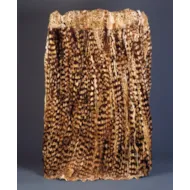A Fine Nguni, South African, 'Kaross' or Cape
A Fine Nguni, South African, ‘Kaross’ or Cape
Made from the pelts of the large spotted Genet or Civet cat
Comprising numerous small pelts finely stitched together with sinew
19th Century
Size : 178 cm long, 142 cm wide – 70 ins long, 56 ins wide
Made from the pelts of the large spotted Genet or Civet cat
Comprising numerous small pelts finely stitched together with sinew
19th Century
Size : 178 cm long, 142 cm wide – 70 ins long, 56 ins wide
With the advent of firearms in the 19th century the sudden increase in the availability of previously scarce materials, such as spotted cat fur, which before had been only obtained as incidental by-products of local medicine-related trapping or casual hunting, led to elaborate and technical feats of hide and fur working. These fur capes were seen as symbolic of the 'imperial' power of the Zulu nation and were mostly confined to the ruling elite.
It is said that King Mpande luxuriated in so much fur 'he would be completely covered' ( JSAI : 46 ). Fur garments were the privilege of royal favourites and eminent men of rank.
The Reverend Woods wrote of the Kaross 'wonderfully light, so light, indeed, that no one could think it capable of impacting much warmth until he has tried it'.
Mrs Parlby and her husband visited the Cape in 1845 and stayed for nine days. Always on the lookout for curios she bought 'a Kaross of eighteen heads, as it is technically called, the sole garment worn by Kaffirs, for four pounds : it is very large and handsome, consisting of the skins of red jackals ….. These skins are much sought after by officers on service, which is perhaps the reason they are so expensive in Cape Town' ( Mrs Parlby : Wanderings of a pilgrim, in search of the picturesque, during four and twenty years in the East, London 1850 ).
It is said that King Mpande luxuriated in so much fur 'he would be completely covered' ( JSAI : 46 ). Fur garments were the privilege of royal favourites and eminent men of rank.
The Reverend Woods wrote of the Kaross 'wonderfully light, so light, indeed, that no one could think it capable of impacting much warmth until he has tried it'.
Mrs Parlby and her husband visited the Cape in 1845 and stayed for nine days. Always on the lookout for curios she bought 'a Kaross of eighteen heads, as it is technically called, the sole garment worn by Kaffirs, for four pounds : it is very large and handsome, consisting of the skins of red jackals ….. These skins are much sought after by officers on service, which is perhaps the reason they are so expensive in Cape Town' ( Mrs Parlby : Wanderings of a pilgrim, in search of the picturesque, during four and twenty years in the East, London 1850 ).
A Fine Nguni, South African, 'Kaross' or Cape

SOLD



